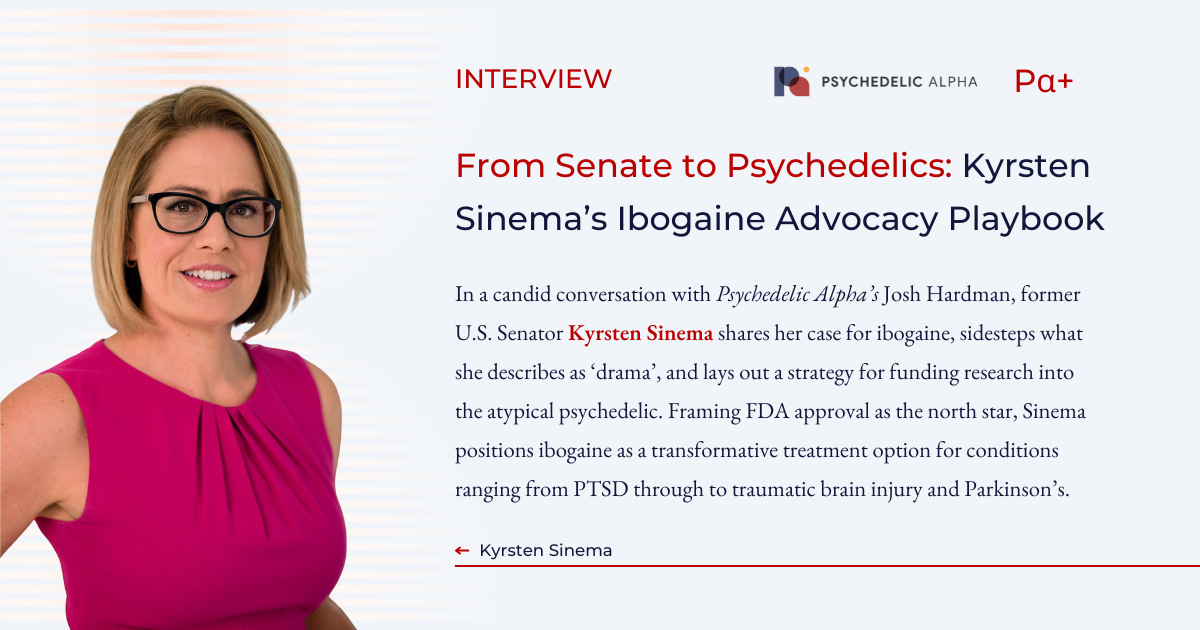Sinema’s Intro to Psychedelics
Josh Hardman, Psychedelic Alpha: I’m a Brit, so you will have to forgive me for my lack of knowledge of you and your career. When I was walking over here to interview you, people I bumped into were surprised I was planning to speak with you. They said that you are very controversial. Why would they say that?
Kyrsten Sinema: Why do people think I’m controversial? Probably because I think for myself and do what I think is right, and I don’t belong to any political party.
Hardman: So you ended up as an independent. Before that, you were a Democrat, and before that, a Green.
Sinema: No. Before that, I was also an independent. My boyfriend was green, and people confuse that.
(Editor’s note: At one point in the early 2000s, Sinema was a local spokeswoman for the Green Party, as the New York Times and other outlets have noted. She also ran for Phoenix City Council as a Green Party activist, as AP News reported.)
Hardman: How did you become interested in psychedelics?
Sinema: Almost two and a half years ago, Spring of ’23, we were in Los Angeles, doing fundraisers for my campaign, and [my colleague] Matt mentioned that he was going down to Mexico, to Ambio [Life Sciences], to experience ibogaine.
I’d never heard of ibogaine and I didn’t know anything about psychedelic medicine, even though I’m a licensed clinical social worker. Matt talked a little bit about ibogaine and why he was going, and then a week later I was in San Diego working again and Matt picked me up at the airport. We drove from San Diego back up to LA for work and in that two-and-a-half-hour drive I asked Matt about his experience. I could tell that something significant had happened in Matt’s life. He started describing the experience to me, and it was very compelling. I thought: ‘Wow, I need to learn more about this.’
So, we finished the work trip, and then probably didn’t see each other for two weeks, and off I went to do my job or whatever. I started researching psychedelic medicine.
Hardman: What did that look like? Did you speak to people?
Sinema: For two weeks I just went down a rabbit hole of research, I just searched it up. Two weeks later, I saw Matt again, and I was like: ‘Let me tell you what I’ve learned!’ I had learned a lot in those two weeks, because I’m a nerd, and what I learned and what I saw in Matt’s life, the change in him so rapidly, really convinced me that this was a breakthrough treatment that could change the lives of veterans.
So then I said, let’s start working on psychedelic medicine. I happened to be a United States Senator and I happened to chair, at the time, the appropriations committee that covered Veterans Affairs, so I had some ability to put language into funding bills to actually do more research, and that’s how we started this.
FDA Approval as the North Star
Hardman: So is FDA approval the ultimate goal in funding research?
Sinema: Oh, yeah, FDA approval is where it’s at.
Hardman: So you’re not interested in rescheduling or anything like that?
Sinema: So here’s the thing, after you get FDA approval, by law, the Drug Enforcement Agency [sic] has 90 days to reschedule a drug. So rescheduling comes automatically after FDA approval.
(Editor’s note: See our Pα+ Library article to learn more about how this might work in practice, i.e., bifurcated scheduling.)
Hardman: But before that, would you support rescheduling it to Schedule II so as to allow medical prescription ahead of an FDA approval?
Sinema: I think FDA approval is the best path forward, because that allows you not only to get the indications for the medication, but it also allows you to then approach the Center for Medicaid Services to get coverage. That’s how you get coverage through insurance companies.
So if you want people in America to get access to this life-saving medication, FDA approval is the best way to go.
Costs of Ibogaine Treatment
Hardman: That’s one of the big concerns, right, the cost? Even if this gets approved, it’s going to be expensive: maybe thirty to fifty grand, for example. Do you think payors would be ready to cover it?
Sinema: Well, you need FDA approval for it. Once you’ve got FDA approval, then you can approach both insurers, and you can approach CMS, and the cost will come down over time. And if you think about it, the cost savings that come from one to two treatments of ibogaine versus the cost of a lifetime of Suboxone and multiple rehabilitation treatments in inpatient facilities for individuals, for instance, who are suffering from opiate addiction, the cost differential is massive. It’s much cheaper to do ibogaine treatment.
In the area where I am the most interested—for traumatic brain injury, Parkinson’s and other neurological disorders—as you’re probably aware, there’s no treatment that’s effective for traumatic brain injuries in our country right now. The treatments that we have for Parkinson’s only slow down the progression of the disease, they don’t reverse it like ibogaine can and treatment becomes much, much more expensive in the later stages of Parkinson’s.
So it’s actually a lot cheaper to approve ibogaine treatment and get it insured than it is to do the tertiary treatments that we’re currently doing for these diseases and disorders.
One and Done?
Hardman: Do you think it’s a ‘one and done’?
Sinema: So the research on traumatic brain injury…


